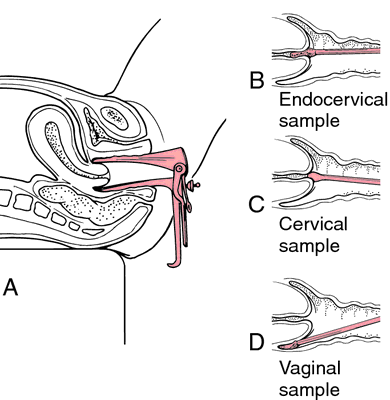Papanicolaou test (smear)
[pap″ah-nik″o-la´oo]a simple, painless test used most commonly to detect cancer of the uterus and cervix; it is based on the discovery by Dr. George N. Papanicolaou (1883–1962) that malignant uterine tumors slough off cancerous cells into surrounding vaginal fluid. Called also Pap test and Pap smear.
The Papanicolaou technique, an exfoliative cytological staining procedure, is used also in diagnosis of lung, stomach, and bladder cancers. It can be performed on any body excretion (urine, feces), secretion (sputum, prostatic fluid, vaginal fluid), or tissue scraping (as from the uterus, cervix, or stomach). The sample is removed from the area being examined, placed on a glass slide, stained, and then studied under a microscope for evidence of abnormal or cancerous cells.
In five minutes the Pap test can reveal uterine or cervical cancer at a stage in which it produces no visible symptoms, has done no damage, and usually can be completely cured. It is recommended that all women over age 18, and younger women who have been sexually active, should have an annual Pap test and pelvic examination.
The Papanicolaou technique, an exfoliative cytological staining procedure, is used also in diagnosis of lung, stomach, and bladder cancers. It can be performed on any body excretion (urine, feces), secretion (sputum, prostatic fluid, vaginal fluid), or tissue scraping (as from the uterus, cervix, or stomach). The sample is removed from the area being examined, placed on a glass slide, stained, and then studied under a microscope for evidence of abnormal or cancerous cells.
In five minutes the Pap test can reveal uterine or cervical cancer at a stage in which it produces no visible symptoms, has done no damage, and usually can be completely cured. It is recommended that all women over age 18, and younger women who have been sexually active, should have an annual Pap test and pelvic examination.

Pap smear. From Lammon et al., 1995.
Miller-Keane Encyclopedia and Dictionary of Medicine, Nursing, and Allied Health, Seventh Edition. © 2003 by Saunders, an imprint of Elsevier, Inc. All rights reserved.
Papanicolaou test
(pä′pə-nē′kə-lou′, păp′ə-nĭk′ə-lou′)n.
The Pap smear.
The American Heritage® Medical Dictionary Copyright © 2007, 2004 by Houghton Mifflin Company. Published by Houghton Mifflin Company. All rights reserved.
Papanicolaou,
George N., Greek-U.S. physician, anatomist, and cytologist, 1883-1962.Papanicolaou examination
Papanicolaou smear - Synonym(s): Pap smear
Papanicolaou smear test - Synonym(s): Pap test
Papanicolaou stain - a multichromatic stain used in cancer screening, especially of gynecologic smears.
Papanicolaou test - Synonym(s): Pap test
Pap smear - vaginal or cervical cells obtained for cytological study. Synonym(s): Papanicolaou smear
Pap test - examination of cells stained with Papanicolaou stain. Synonym(s): Papanicolaou smear test; Papanicolaou test
Medical Eponyms © Farlex 2012